The Role of Millimeter-Waves in the Distance Measurement Accuracy of an FMCW Radar Sensor
Abstract
1. Introduction
2. Materials and Methods
2.1. Conventional FMCW Radar
- The estimation accuracy of is limited by the bin width of the FFT spectrum (FFT bin width is the frequency gap between two consecutive spectral lines in the FFT spectrum). The FFT bin width is given by where and denote the sampling frequency and the number of samples, respectively.
- Zero padding is used to interpolate the FFT spectrum and hence increase its frequency resolution. However, zero padding leads to a massive increase in the computational complexity.
- If two or more targets are located so close to each other such that their corresponding peaks in the frequency domain lie within the 3 dB width of the chosen window function, then no amount of zero padding can resolve the target peaks.
2.2. Enhancing the Distance Measurement Accuracy of an FMCW Radar
2.2.1. Frequency-Estimation Algorithm
- The time-domain samples captured by the ADC are used to calculate the FFT over a frequency span of . The zero padding factor is kept as one; hence the number of FFT points is the same as the number of ADC samples. The frequency corresponding to the peak amplitude of the FFT spectrum is termed as the coarse frequency estimate . In an ideal scenario, when is substituted in Equation (1), it provides an absolutely accurate value of the target distance provided is an integral multiple of the FFT bin width (i.e., ). In every other case, leads to an error in the distance measurement. This error has a maximum limit of one-half of the FFT bin width on either side of the FFT spectral line corresponding to ; hence the ideal frequency estimate is given by Equation (4).
- The CZT is calculated for the ADC samples over a narrowband frequency range, whose lower and upper limits are given by Equations (5) and (6), respectively.The CZT frequency interval is kept slightly larger than required (i.e., two FFT bins instead of one are used) due to practical reasons. The number of points at which the CZT is calculated () is same as the ADC sample length (). The values of complex numbers and , which define the z-plane contour used for calculating the CZT, are given by Equations (7) and (8), respectively.The frequency corresponding to the peak value of the CZT spectrum provides a finer frequency estimate (), whose accuracy is better than the accuracy of by a factor of . Consequently, the value of (i.e., the frequency corresponding to the ideal target distance) after calculating the CZT is given by Equation (9)
- The CZT is calculated a second time to get an even finer estimate of the IF frequency i.e., . In an ideal scenario, which contains a single target peak in the frequency spectrum, the accuracy of the estimated IF frequency () improves by a factor of after the iteration of the CZT as shown by Equation (10). However, in a real scenario, the target peak is influenced by the presence of effects such as other spectral peaks arising from surrounding objects, various types of noise and windowing, which restrict the highest achievable accuracy of the IF frequency estimate. In this work, it is shown that two CZT iterations are found to be sufficient to achieve this accuracy limit of the IF frequency estimate.
2.2.2. Phase-Estimation Algorithm
- The radar-to-target distance is divided into number of unambiguous range cells as shown in Figure 4. The length of each range cell is λstart/2. As described in Section 2.2.1, the frequency estimation algorithm provides an IF frequency estimate termed after executing the FFT and two iterations of the CZT. On substituting in Equation (1), a coarse estimate of the target range () is obtained, which indicates the range cell in which the target is located, as shown by Equation (12).
- The initial phase of the IF signal ) is equal to the phase difference of the Tx and Rx FMCW chirps (note that the term ‘chirp’ is used instead of ‘ramp’, since the phase estimation algorithm is implemented in the time domain) at that instance of time. Therefore, the information regarding the time delay between the Tx and Rx chirps is stored in the value. Hence, within the range cell, a fine estimate of the target distance is obtained from by using Equation (13). The final estimation of the target distance is given by Equation (14) [1].
- The value of is obtained by executing a cross-correlation function between the IF signal captured by the ADC and a reference complex harmonic signal, which is formed using (obtained from frequencyestimation algorithm). These two signals are shown by Equations (15) and (16), respectively, and their cross-correlation function is shown by Equation (17).and denote normalized values of and respectively, with respect to . The noise embedded in the signal being uncorrelated gets suppressed during cross-correlation. Further, the cross-correlation results in a sinc function, whose argument provides the value of Alternatively, can also be determined from the peak of the frequency spectrum calculated using the CZT. This alternative method has been used in [1].
2.2.3. Limitations of the Frequency- and Phase-Estimation Algorithm
2.3. Measurement Setup
- As the target distance increases, the time delay between the Tx and Rx signal () becomes a significant fraction of the sweep time (). In other words, the overlap between the Tx and Rx signal decreases (see Figure 1) and hence lesser number of samples are available for estimating the target distance.
- The radar SNR () decreases drastically with an increase in the target distance (), since as shown in Equation (21). This in turn degrades the distance measurement accuracy as shown by the CRLB frequency and phase equations of Equations (19) and (20), respectively.
- In order to perform distance measurements with an accuracy of a few micrometers, an extremely stable measurement setup, free from the influence of mechanical vibrations, is required. The measurement setup shown in Figure 5 provides a maximum target distance of around 2.5 m.
3. Results
3.1. Mean Distance Measurement Error after the First CZT Iteration
3.2. Mean Distance Measurement Error After the Second CZT Iteration
3.3. Mean Distance Measurement Error after Combined Frequency- and Phase-Estimation
3.4. Standard Deviation of Distance Measurement Error after Combined Frequency- and Phase-Estimation
4. Discussion
- In terms of frequency estimation, the implementation of the FFT, followed by the two CZT iterations is sufficient to achieve a distance measurement error of tens of micrometers, provided standard FMCW radar parameters (e.g., bandwidth, sweep time and Tx power) and an optimum measurement scenario (e.g., single target and short range), as shown in this work are used. The mean distance measurement error based solely on the frequency-estimation method is found to be approximately 40 μm for the 60 GHz FMCW radar and 30 μm for the 122 GHz FMCW radar.
- After the second CZT iteration, the bin width becomes extremely small (i.e., of the order of mHz) and therefore the undesirable effects present in a real scenario easily result in a slight frequency drift of the target peak. Consequently, a higher number of the CZT iterations could not lead to a further improvement of the distance measurement accuracy.
- The phase-estimation method improves the distance measurement accuracy of both the 60 GHz and 122 GHz FMCW radar by nearly a factor of 10. This tremendous improvement is attributed to the fact that IF signal phase is more sensitive to tiny changes in the target range (over an unambiguous range of ).
- The variance of the distance measurement error measured using the 122 GHz FMCW radar is nearly four times lower than the 60 GHz FMCW radar. Therefore, the CRLB of phase estimation for an FMCW radar has been experimentally validated. After combined frequency- and phase-estimation of 5100 continuous distance measurements, the accuracy of the 60 GHz FMCW radar was found to be and the accuracy of the 122 GHz FMCW radar was found to be (the accuracy is specified as mean error for a normal distribution curve).
Author Contributions
Funding
Acknowledgments
Conflicts of Interest
References
- Scherr, S.; Ayhan, S.; Fischbach, B.; Bhutani, A.; Pauli, M.; Zwick, T. An Efficient Frequency and Phase Estimation Algorithm With CRB Performance for FMCW Radar Applications. IEEE Trans. Instrum. Meas. 2015, 64, 1868–1875. [Google Scholar] [CrossRef]
- Ayhan, S.; Scherr, S.; Pahl, P.; Kayser, T.; Pauli, M.; Zwick, T. High-Accuracy Range Detection Radar Sensor for Hydraulic Cylinders. IEEE Sens. J. 2014, 14, 734–746. [Google Scholar] [CrossRef]
- Ayhan, S.; Scherr, S.; Bhutani, A.; Fischbach, B.; Pauli, M.; Zwick, T. Impact of Frequency Ramp Nonlinearity, Phase Noise, and SNR on FMCW Radar Accuracy. IEEE Trans. Microw. Theory Tech. 2016, 64, 3290–3301. [Google Scholar] [CrossRef]
- Scherr, S.; Afroz, R.; Ayhan, S.; Thomas, S.; Jaeschke, T.; Marahrens, S.; Bhutani, A.; Pauli, M.; Pohl, N.; Zwick, T. Influence of Radar Targets on the Accuracy of FMCW Radar Distance Measurements. IEEE Trans. Microw. Theory Tech. 2017, 65, 3640–3647. [Google Scholar] [CrossRef]
- Jaeschke, T.; Bredendiek, C.; Küppers, S.; Pohl, N. High-Precision D-Band FMCW-Radar Sensor Based on a Wideband SiGe-Transceiver MMIC. IEEE Trans. Microw. Theory Tech. 2014, 62, 3582–3597. [Google Scholar] [CrossRef]
- Thomas, S.; Bredendiek, C.; Pohl, N. A SiGe-Based 240-GHz FMCW Radar System for High-Resolution Measurements. IEEE Trans. Microw. Theory Tech. 2019. [Google Scholar] [CrossRef]
- Ramasubramanian, K.; Instruments, T. Using a Complex-Baseband Architecture in FMCW Radar Systems. Available online: http://www.ti.com/lit/wp/spyy007/spyy007.pdf (accessed on 5 August 2019).
- Harris, F.J. On the use of windows for harmonic analysis with the discrete Fourier transform. Proc. IEEE 1978, 66, 51–83. [Google Scholar] [CrossRef]
- Ayhan, S.; Pauli, M.; Kayser, T.; Scherr, S.; Zwick, T. FMCW radar system with additional phase evaluation for high accuracy range detection. In Proceedings of the 2011 8th European Radar Conference, Manchester, UK, 12–14 October 2011; pp. 117–120. [Google Scholar]
- Rabiner, L.; Schafer, R.; Rader, C. The chirp z-transform algorithm. IEEE Trans. Audio Electroacoustics 1969, 17, 86–92. [Google Scholar] [CrossRef]
- Rabiner, L.R.; Schafer, R.W.; Rader, C.M. The chirp z-transform algorithm and its application. Bell Syst. Tech. J. 1969, 48, 1249–1292. [Google Scholar] [CrossRef]
- Rabiner, L. The chirp z-transform algorithm—A lesson in serendipity. IEEE Signal Process. Mag. 2004, 21, 118–119. [Google Scholar] [CrossRef]
- Bluestein, L. A linear filtering approach to the computation of discrete Fourier transform. IEEE Trans. Audio Electroacoustics 1970, 18, 451–455. [Google Scholar] [CrossRef]
- Skolnik, M.L. Introduction to RADAR Systems; Tata McGraw-Hill: New Delhi, India, 2001. [Google Scholar]
- Kay, S.M. Fundamentals of Statistical Signal Processing: Estimation Theory; Prentice-Hall, Inc.: New Jersey, NJ, USA, 1993. [Google Scholar]
- Nasr, I.; Jungmaier, R.; Baheti, A.; Noppeney, D.; Bal, J.S.; Wojnowski, M.; Karagozler, E.; Raja, H.; Lien, J.; Poupyrev, I.; et al. A Highly Integrated 60 GHz 6-Channel Transceiver with Antenna-in-Package for Smart-Sensing and Short-Range Communications. IEEE J. Solid-State Circuits 2016, 51, 2066–2076. [Google Scholar] [CrossRef]
- Bhutani, A.; Göttel, B.; Lipp, A.; Zwick, T. Packaging Solution Based on Low-Temperature Cofired Ceramic Technology for Frequencies Beyond 100 GHz. IEEE Trans. Compon. Packag. Manuf. Technol. 2019, 9, 945–954. [Google Scholar] [CrossRef]
- Scherr, S.; Gottel, B.; Ayhan, S.; Bhutani, A.; Pauli, M.; Winkler, W.; Scheytt, J.; Zwick, T. Miniaturized 122 GHz ISM band FMCW radar with micrometer accuracy. In Proceedings of the 2015 European Radar Conference (EuRAD), Paris, France, 9–11 September 2015; pp. 277–280. [Google Scholar] [CrossRef]
- PI Ultrasonic Piezomotors: High Velocity and Precision. Karlsruhe, Germany. Available online: http://www.dyneos.ch/pdf/Dyneos_Ultrasonic%20Piezomotors_E.pdf (accessed on 5 August 2019).
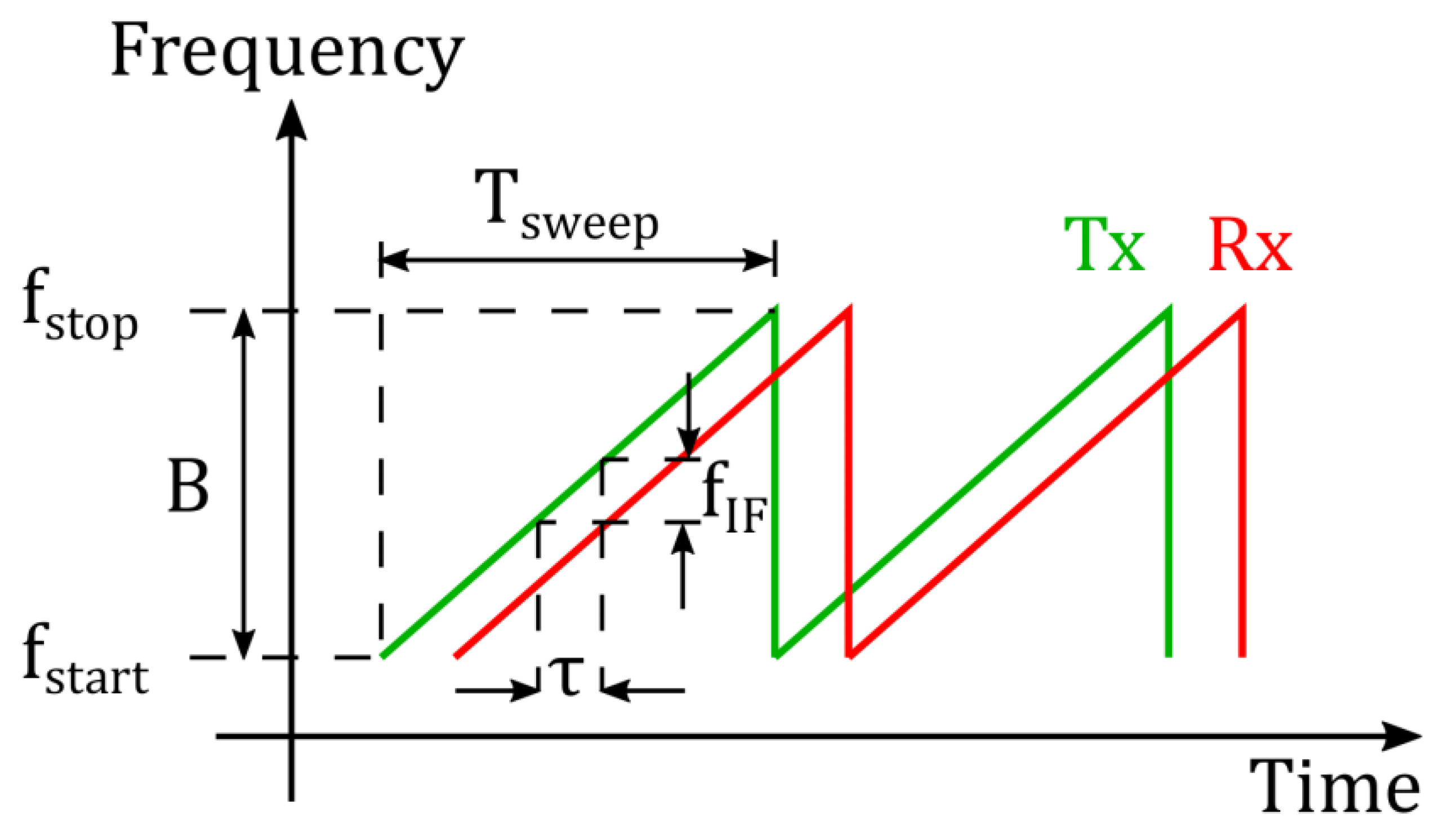
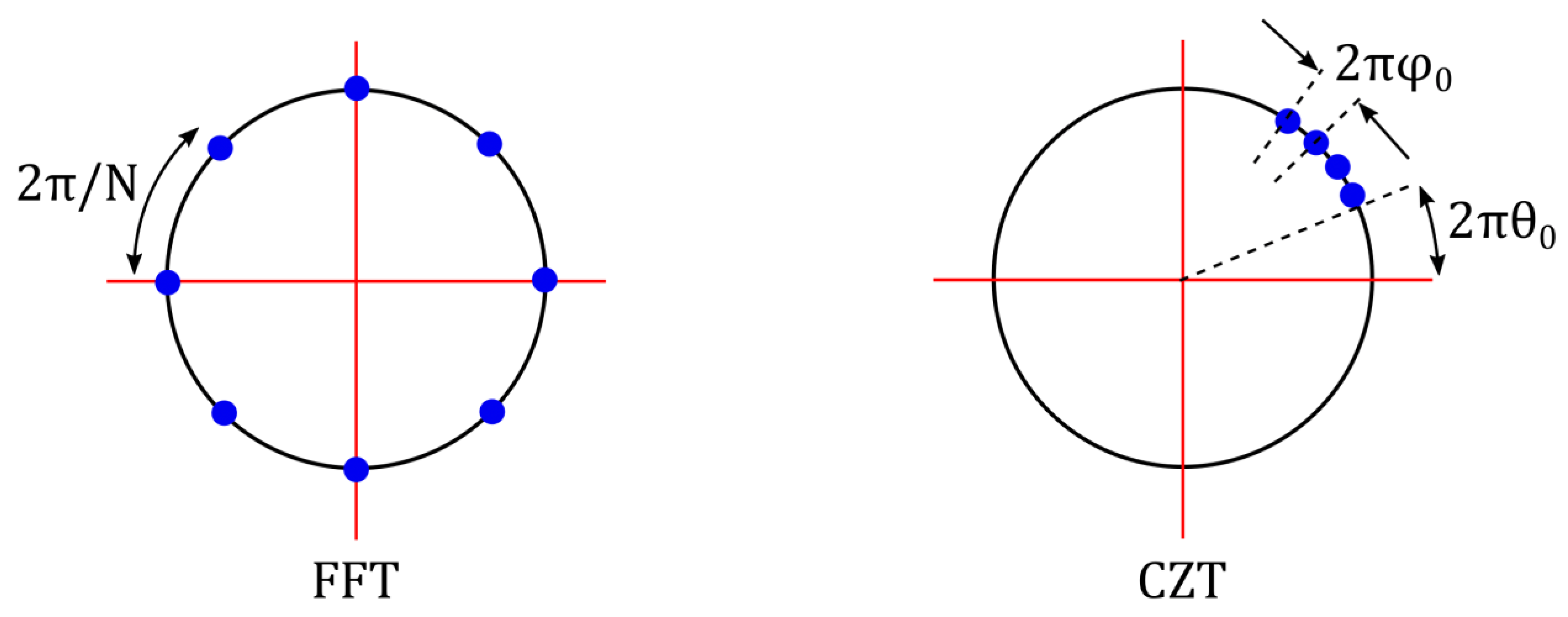
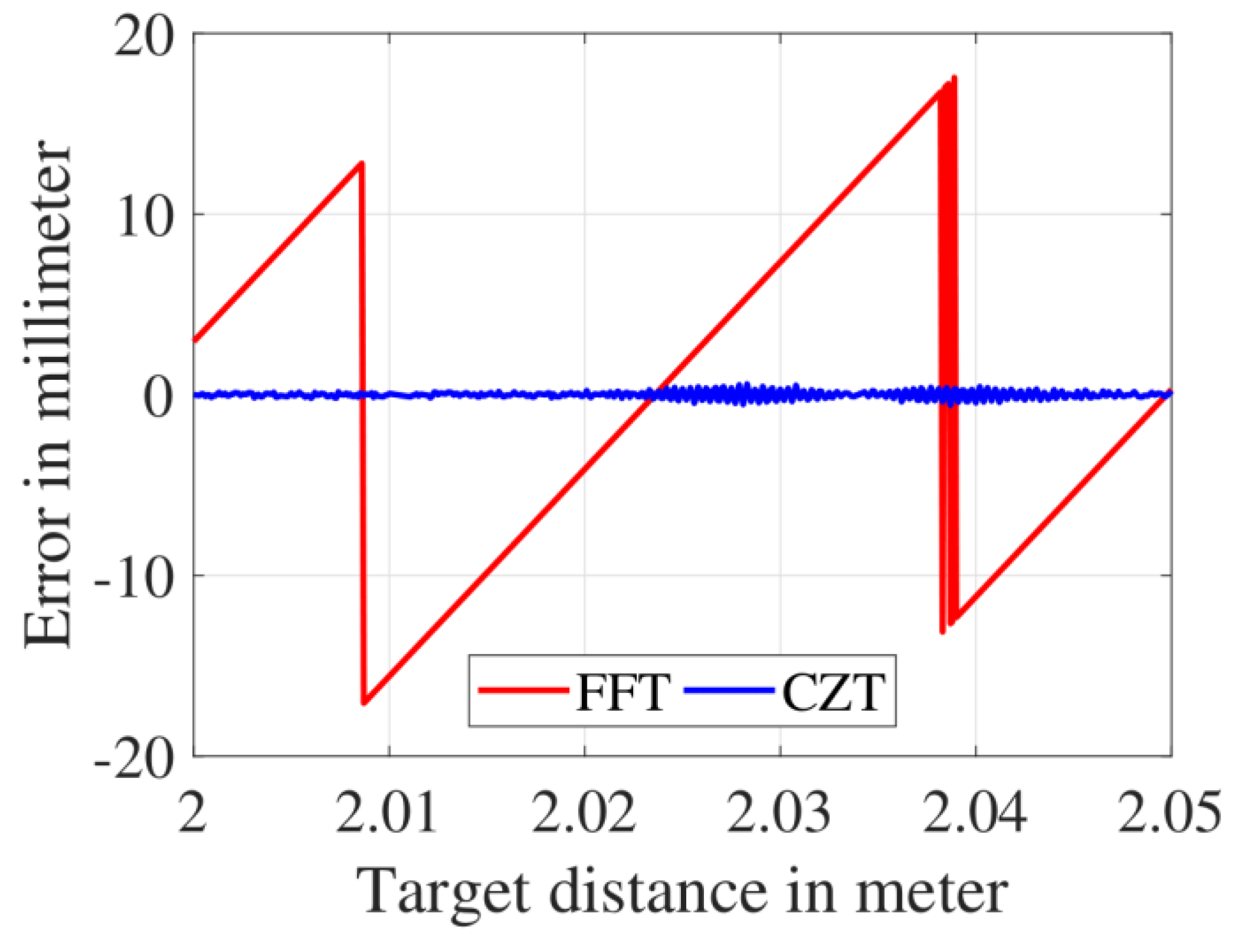




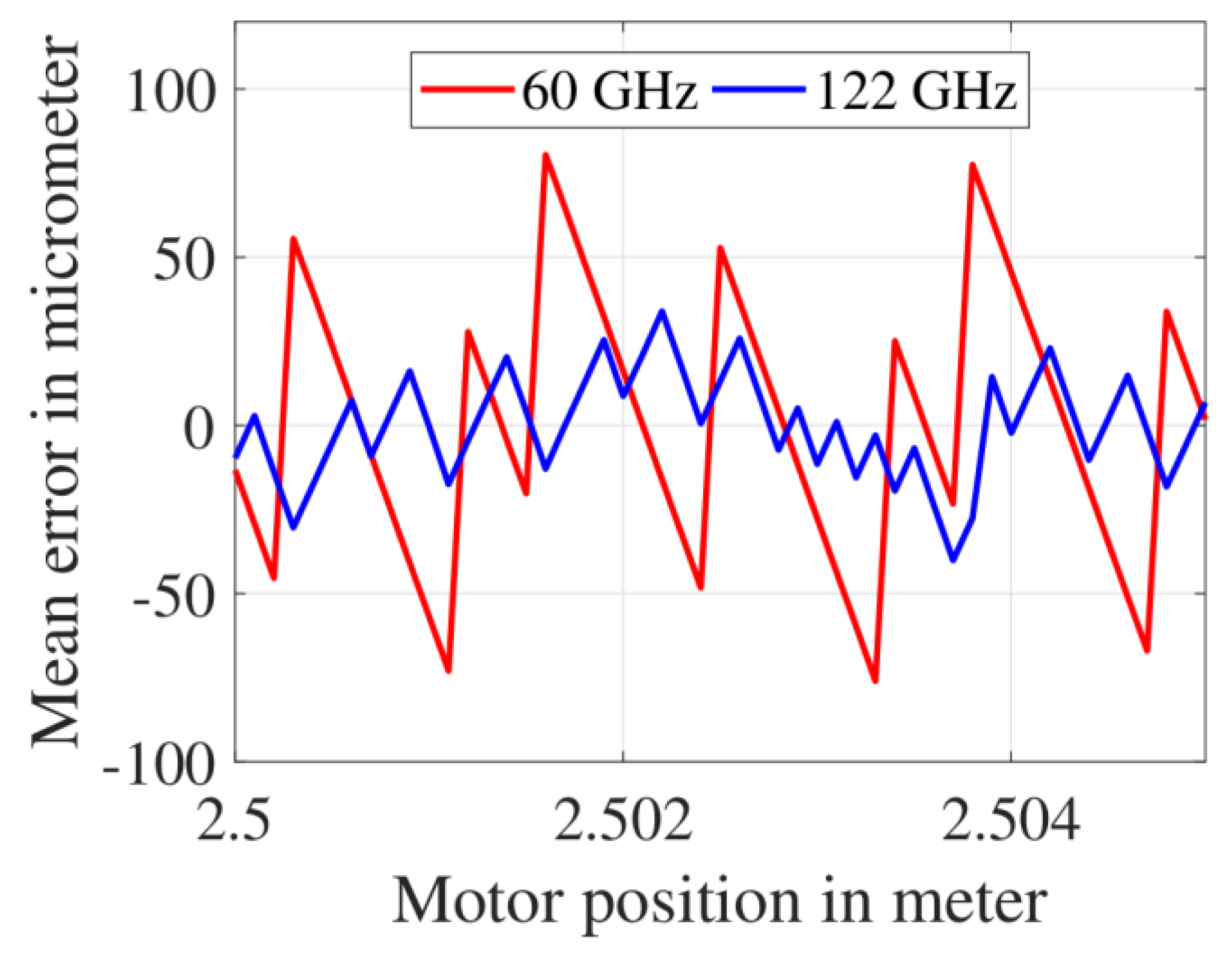

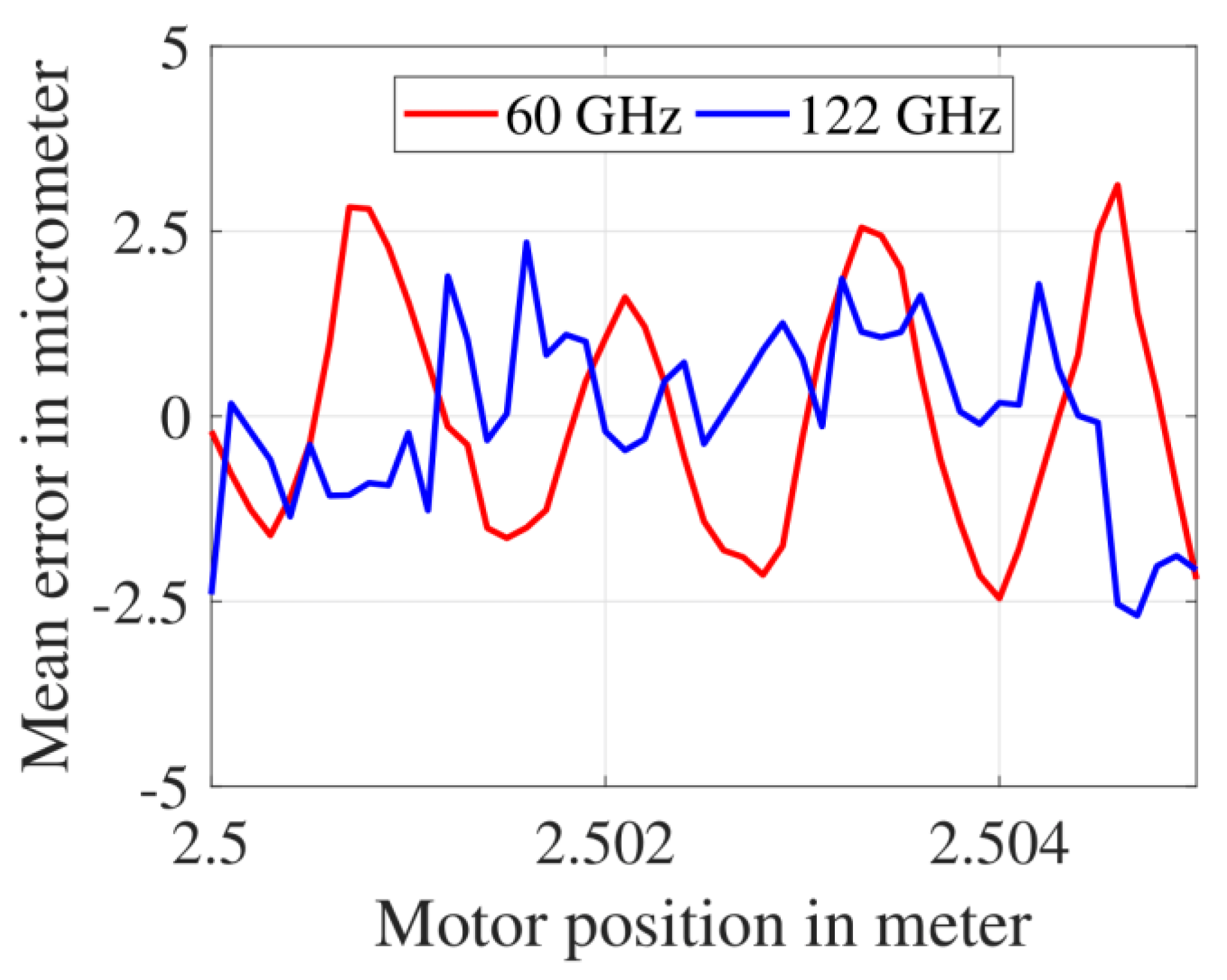
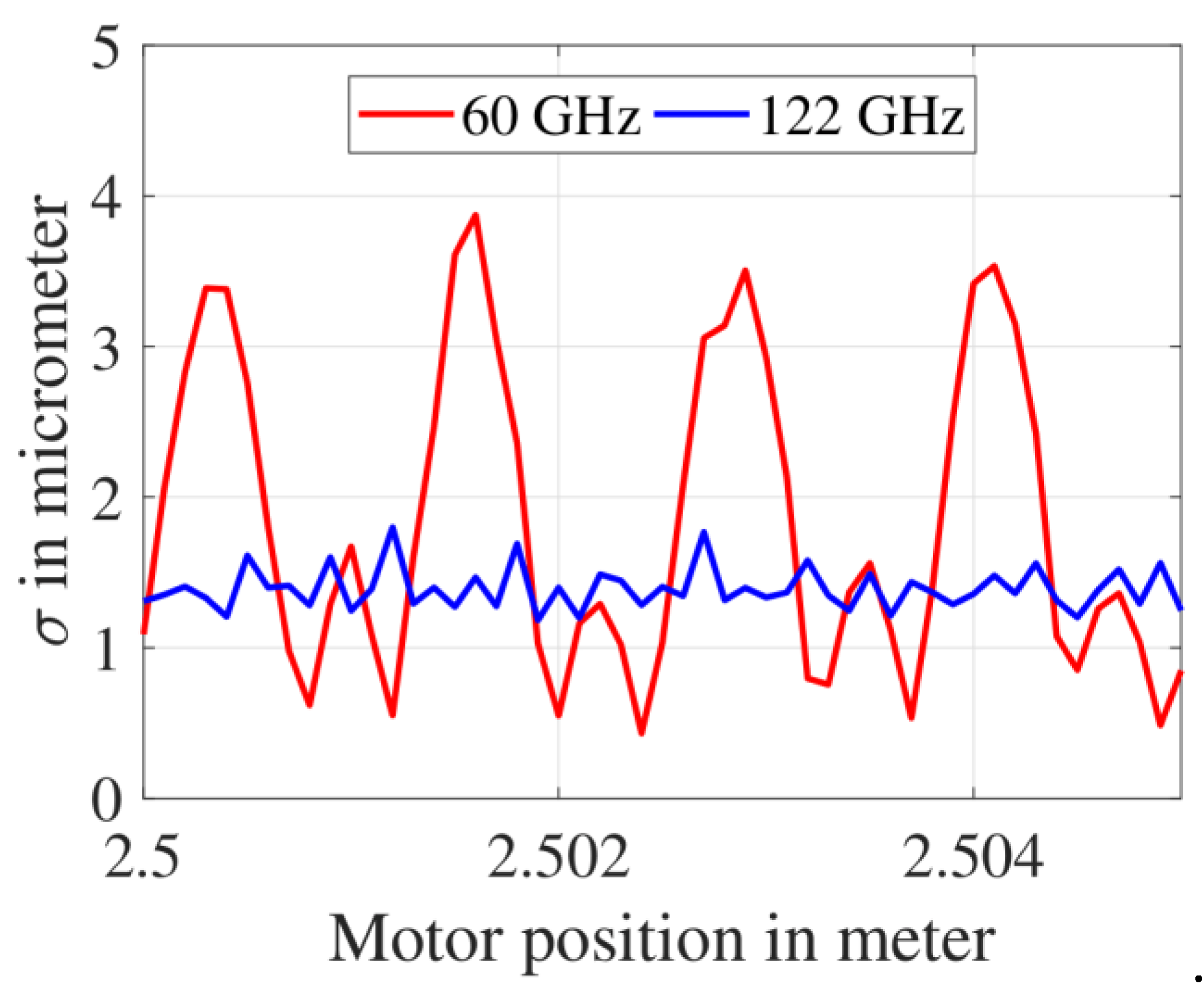
| Parameter | 60 GHz FMCW Radar | 122 GHz FMCW Radar |
|---|---|---|
| Start frequency () | 57.5 GHz | 120 GHz |
| Bandwidth () | 5 GHz | 5 GHz |
| Sweep time () | 256 μs | 384 μs |
| Tx power () | 0 dBm | –3 dBm |
| Tx/Rx gain with lens () | 25 dBi | 25 dBi |
| FFT + CZT | FFT + 2 × CZT | FFT + 2 × CZT + Phase | ||
|---|---|---|---|---|
| Mean Error | Mean Error | Mean Error | σ | |
| 60 GHz FMCW Radar | 81 μm | 42 μm | 3.2 μm | 3.8 μm |
| 122 GHz FMCW Radar | 40 μm | 33 μm | 2.6 μm | 1.9 μm |
© 2019 by the authors. Licensee MDPI, Basel, Switzerland. This article is an open access article distributed under the terms and conditions of the Creative Commons Attribution (CC BY) license (http://creativecommons.org/licenses/by/4.0/).
Share and Cite
Bhutani, A.; Marahrens, S.; Gehringer, M.; Göttel, B.; Pauli, M.; Zwick, T. The Role of Millimeter-Waves in the Distance Measurement Accuracy of an FMCW Radar Sensor. Sensors 2019, 19, 3938. https://doi.org/10.3390/s19183938
Bhutani A, Marahrens S, Gehringer M, Göttel B, Pauli M, Zwick T. The Role of Millimeter-Waves in the Distance Measurement Accuracy of an FMCW Radar Sensor. Sensors. 2019; 19(18):3938. https://doi.org/10.3390/s19183938
Chicago/Turabian StyleBhutani, Akanksha, Sören Marahrens, Michael Gehringer, Benjamin Göttel, Mario Pauli, and Thomas Zwick. 2019. "The Role of Millimeter-Waves in the Distance Measurement Accuracy of an FMCW Radar Sensor" Sensors 19, no. 18: 3938. https://doi.org/10.3390/s19183938
APA StyleBhutani, A., Marahrens, S., Gehringer, M., Göttel, B., Pauli, M., & Zwick, T. (2019). The Role of Millimeter-Waves in the Distance Measurement Accuracy of an FMCW Radar Sensor. Sensors, 19(18), 3938. https://doi.org/10.3390/s19183938






